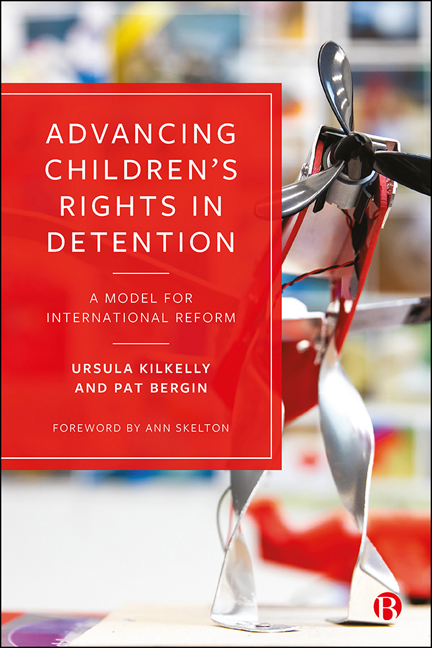Book contents
- Frontmatter
- Contents
- List of Cases and Instruments
- List of Figures
- About the Authors
- Acknowledgements
- Foreword
- Introduction
- 1 Children’s Rights in Detention
- 2 An International Perspective
- 3 Irish Youth Justice Law and Policy
- 4 Introducing Child Detention in Ireland
- 5 Oberstown and the Process of Change
- 6 Implementing Children’s Rights in Detention
- 7 Children’s Rights to Protection from Harm
- 8 Staff Wellbeing and Communication
- 9 International and National Influences and Advocacy
- 10 Reflections: Enablers and Barriers to Reform
- Afterword
- References
- Index
1 - Children’s Rights in Detention
Published online by Cambridge University Press: 13 May 2022
- Frontmatter
- Contents
- List of Cases and Instruments
- List of Figures
- About the Authors
- Acknowledgements
- Foreword
- Introduction
- 1 Children’s Rights in Detention
- 2 An International Perspective
- 3 Irish Youth Justice Law and Policy
- 4 Introducing Child Detention in Ireland
- 5 Oberstown and the Process of Change
- 6 Implementing Children’s Rights in Detention
- 7 Children’s Rights to Protection from Harm
- 8 Staff Wellbeing and Communication
- 9 International and National Influences and Advocacy
- 10 Reflections: Enablers and Barriers to Reform
- Afterword
- References
- Index
Summary
Introduction
The United Nations Convention on the Rights of the Child (CRC) was adopted in 1989 and is the most highly ratified instrument in human rights law, setting the minimum standards to which children are entitled across their childhood (Tobin, 2019). The Committee on the Rights of the Child (the CRC Committee) has played an important role, interpreting the CRC in its General Comments and helping to improve implementation at a national level through the state party reporting process (Sloth-Nielsen, 2019). Over the years, the CRC's standards have been supplemented by instruments adopted at international and regional levels, producing a now comprehensive framework for the legal protection of children's rights.
Children who come into conflict with the law were an early concern of the international community, resulting in two substantial provisions in the CRC – Articles 37 and 40 – that address the child's rights in youth justice and detention (Liefaard, 2020). Article 40(1) of the CRC recognizes the right of children in conflict with the law to be treated in a manner consistent with their sense of dignity and worth, reinforcing the child's respect for the rights and freedoms of others and which takes into account the child's age and the desirability of promoting their reintegration into society. It requires states to have regard to the child's due process rights and prescribes measures of specialization and diversion as key to the rights-based approach to youth justice. Article 37 recognizes that children deprived of liberty are entitled to respect for dignity and age-appropriate treatment and requires states to ensure that detention is ‘a measure of last resort’, used for ‘the shortest appropriate period of time’ (Article 37(b), CRC). Children must be separated from adults in detention, have the right to maintain contact with family through correspondence and visits, and the right to prompt access to legal and other appropriate assistance (Article 37(c) and (d), CRC). It is implicit in Article 37 that detention can cause children harm in light of their vulnerability and stage of development. In order to minimize this harm, and to prevent the child from reoffending, international instruments set out the rights to which children in detention are entitled and the measures that states must take to ensure those rights are protected.
- Type
- Chapter
- Information
- Advancing Children's Rights in DetentionA Model for International Reform, pp. 5 - 19Publisher: Bristol University PressPrint publication year: 2021



